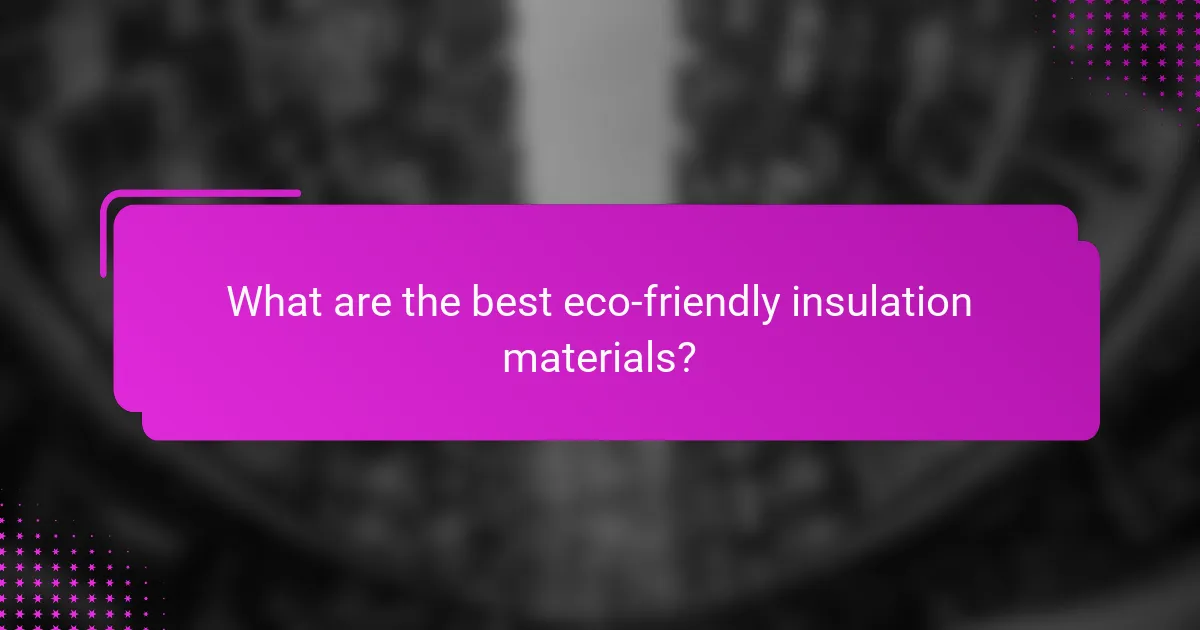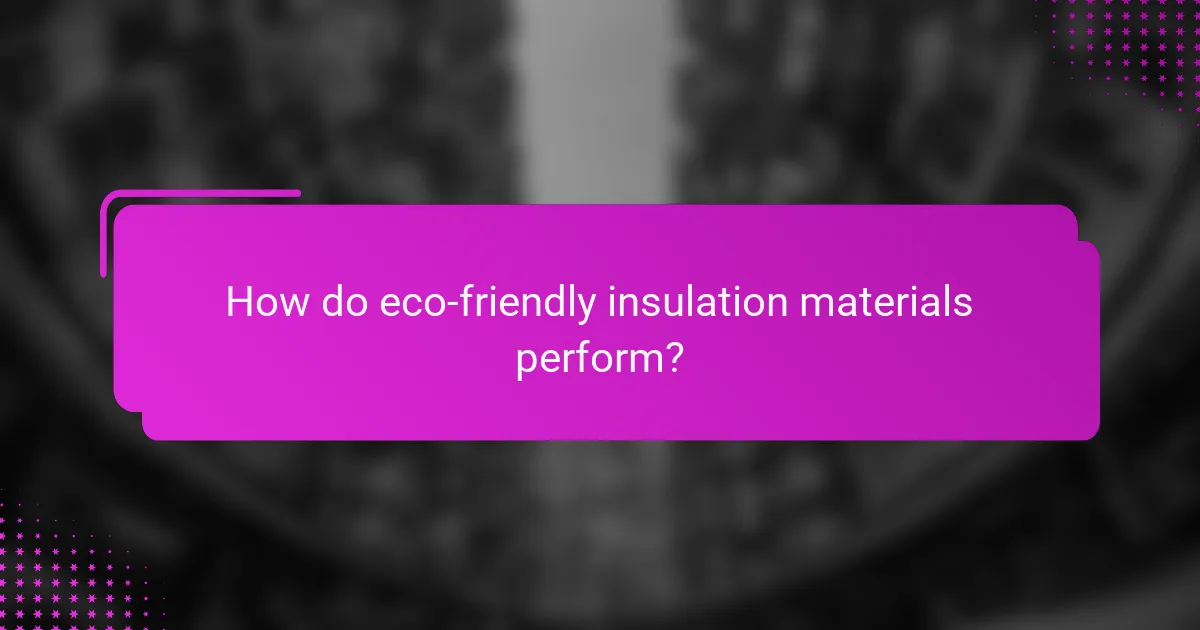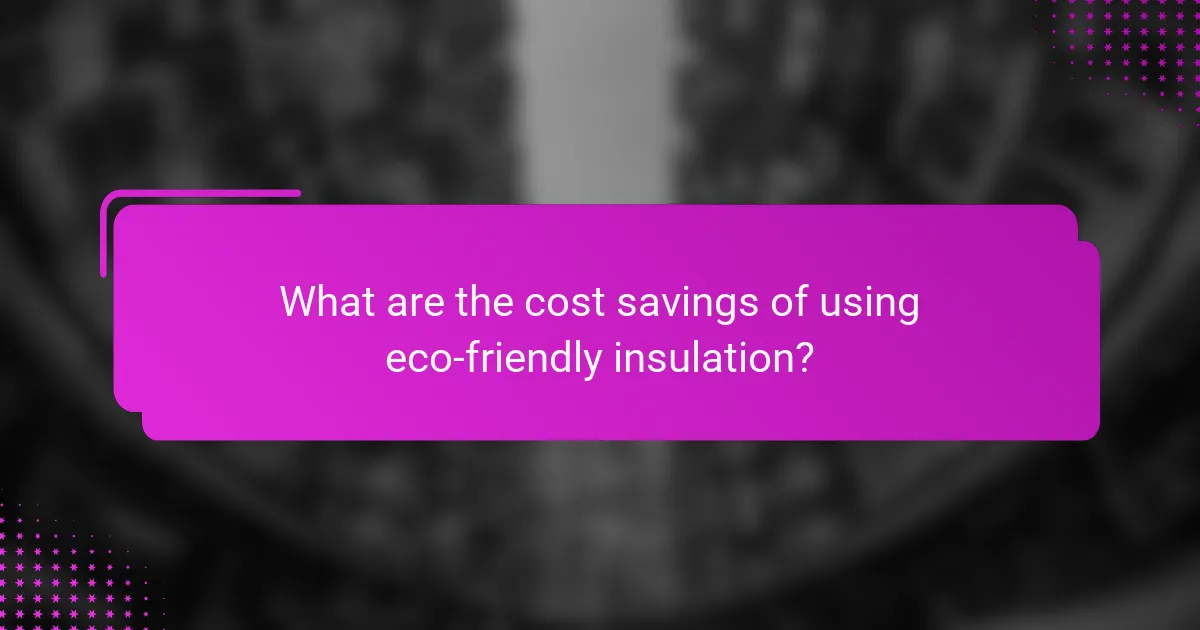Eco-friendly insulation materials, such as cellulose, spray foam, mineral wool, hemp, and sheep’s wool, offer effective thermal performance while promoting sustainability through the use of renewable or recycled resources. These materials not only enhance energy efficiency and soundproofing but also provide moisture resistance, making them a smart choice for environmentally conscious homeowners. Although the initial costs may be higher, the long-term savings on energy bills and potential incentives make eco-friendly insulation a financially advantageous investment.

What are the best eco-friendly insulation materials?
The best eco-friendly insulation materials include cellulose, spray foam, mineral wool, hemp, and sheep’s wool. These materials not only provide effective thermal performance but also contribute to sustainability by using renewable resources or recycled content.
Cellulose insulation
Cellulose insulation is made primarily from recycled paper products, making it a highly sustainable choice. It is treated with fire retardants to enhance safety and can be blown into walls or attics, providing excellent coverage and thermal performance.
When considering cellulose, look for products with a high recycled content and ensure they meet local fire safety regulations. Its R-value typically ranges from 3.2 to 3.8 per inch, making it a competitive option for energy efficiency.
Spray foam insulation
Spray foam insulation consists of a mixture of isocyanates and polyols that expand upon application, creating an airtight seal. This type of insulation is effective at reducing air leaks, which can significantly improve energy efficiency in homes.
While spray foam offers high R-values (around 6 to 7 per inch), it is essential to consider its environmental impact, as some formulations may contain harmful chemicals. Opt for low or no VOC (volatile organic compounds) options to minimize health risks.
Mineral wool insulation
Mineral wool insulation, also known as rock wool or slag wool, is made from natural or recycled materials, providing excellent thermal and acoustic insulation. It is naturally fire-resistant and does not promote mold growth, making it a safe choice for various applications.
With an R-value of approximately 3.2 to 4.2 per inch, mineral wool is effective in both residential and commercial settings. Ensure that the product complies with local building codes for insulation materials.
Hemp insulation
Hemp insulation is derived from the fibers of the hemp plant, offering a renewable and biodegradable option. It has good thermal performance and moisture-regulating properties, making it suitable for a variety of climates.
Hemp insulation typically has an R-value of around 3.5 per inch. When choosing hemp insulation, look for products that are certified organic to ensure sustainability and avoid harmful chemicals.
Sheep’s wool insulation
Sheep’s wool insulation is a natural, renewable material that provides excellent thermal performance and moisture management. It can absorb and release moisture without losing its insulating properties, making it ideal for maintaining indoor air quality.
With an R-value of about 3.5 to 4 per inch, sheep’s wool is a viable choice for eco-conscious homeowners. Ensure that the wool is sourced from ethical suppliers to support sustainable practices in the wool industry.

How do eco-friendly insulation materials perform?
Eco-friendly insulation materials typically perform well in terms of energy efficiency, soundproofing, and moisture resistance. Their effectiveness can vary based on the specific material used, installation quality, and environmental conditions.
Thermal performance
Thermal performance refers to an insulation material’s ability to resist heat flow. Eco-friendly options like cellulose, sheep’s wool, and cork often have R-values ranging from low to mid-levels, making them suitable for various climates. For optimal energy savings, ensure that the insulation is properly installed to minimize air leaks.
When selecting insulation, consider the local climate. In colder regions, materials with higher R-values are preferable, while in warmer areas, lower R-values may suffice. Always check for compliance with local building codes regarding insulation standards.
Soundproofing capabilities
Eco-friendly insulation materials can significantly reduce sound transmission, enhancing comfort in residential and commercial spaces. Materials such as recycled denim and mineral wool excel in soundproofing due to their density and fibrous structure.
When evaluating soundproofing, consider both the material’s thickness and density. Thicker insulation generally provides better sound absorption. For maximum effectiveness, combine insulation with sound-dampening barriers in walls and ceilings.
Moisture resistance
Moisture resistance is crucial for preventing mold and maintaining indoor air quality. Some eco-friendly insulation materials, like closed-cell spray foam, offer excellent moisture resistance, while others, like cellulose, require proper vapor barriers to mitigate moisture issues.
To ensure moisture resistance, assess the installation environment and potential sources of humidity. In areas prone to dampness, choose materials specifically designed for moisture control and consider implementing additional ventilation strategies to enhance overall performance.

What are the cost savings of using eco-friendly insulation?
Using eco-friendly insulation can lead to significant cost savings over time due to lower energy bills and potential incentives. While the initial investment may be higher, the long-term benefits often outweigh these costs, making it a financially sound choice for homeowners.
Initial investment comparison
The upfront cost of eco-friendly insulation materials, such as cellulose or sheep’s wool, can be higher than traditional options like fiberglass. For example, cellulose may range from $1.00 to $3.00 per square foot, while fiberglass typically costs between $0.50 and $2.00. However, considering the durability and performance of eco-friendly materials, the initial investment can be justified.
It’s essential to evaluate the total cost of installation, including labor, which can vary based on the material chosen and the complexity of the project. Comparing quotes from multiple contractors can help identify the best value for your insulation needs.
Long-term energy savings
Eco-friendly insulation often provides better thermal performance, which can lead to substantial energy savings. Homeowners may see reductions in heating and cooling costs by 20% to 50%, depending on the climate and insulation type. For instance, a well-insulated home can save hundreds of dollars annually on energy bills.
Additionally, eco-friendly options tend to have a longer lifespan, meaning fewer replacements over time. This durability contributes to ongoing savings and reduces the environmental impact associated with manufacturing and disposing of insulation materials.
Tax incentives and rebates

What factors should you consider when choosing insulation?
When selecting insulation, consider factors such as R-value, environmental impact, and installation requirements. These elements directly influence the effectiveness, sustainability, and practicality of the insulation in your home or building.
R-value and thermal resistance
The R-value measures insulation’s thermal resistance, indicating its ability to resist heat flow. Higher R-values suggest better insulation performance, which is crucial for energy efficiency. For residential applications, R-values typically range from 13 to 38, depending on climate and building type.
When choosing insulation, consider the recommended R-value for your region, which can vary significantly. For instance, colder climates may require R-values closer to the upper end of the range to maintain comfortable indoor temperatures.
Environmental impact
Eco-friendly insulation materials, such as cellulose, sheep’s wool, and recycled denim, have lower environmental impacts compared to traditional options like fiberglass. These materials often use renewable resources and can reduce waste in landfills.
Additionally, consider the lifecycle of the insulation, including its production, installation, and disposal. Look for certifications like GreenGuard or Energy Star to ensure the materials meet environmental standards.
Installation requirements
Installation requirements can vary widely depending on the type of insulation chosen. Some materials, like spray foam, may require professional installation due to their complexity, while others, such as batts or rolls, can be installed by homeowners with basic skills.
Be aware of local building codes and regulations that may dictate specific insulation types or installation methods. Proper installation is crucial for maximizing insulation performance and avoiding issues like moisture buildup or air leaks.

Where can you find eco-friendly insulation suppliers in the US?
Eco-friendly insulation suppliers in the US can be found through local retailers, national brands, and online platforms. These sources provide a variety of sustainable insulation options that meet environmental standards and offer effective thermal performance.
Local suppliers in California
California has a robust market for eco-friendly insulation, with many local suppliers specializing in sustainable materials. Look for businesses that offer products like cellulose, sheep’s wool, or recycled denim insulation. These materials not only provide excellent thermal performance but also align with California’s stringent energy efficiency regulations.
When selecting a local supplier, consider visiting their showroom to see samples and discuss your specific insulation needs. Many suppliers also provide installation services, which can simplify the process.
National brands like GreenFiber
National brands such as GreenFiber offer eco-friendly insulation solutions that are widely available across the US. GreenFiber specializes in cellulose insulation made from recycled paper, which provides excellent thermal resistance and soundproofing. Their products are often certified by recognized standards, ensuring quality and performance.
When choosing a national brand, compare their product offerings and certifications. Many brands provide detailed information on their environmental impact and energy savings, which can help you make an informed decision.
Online retailers
Online retailers provide a convenient way to access a wide range of eco-friendly insulation materials. Websites like Amazon and specialized construction supply stores offer various options, from spray foam to natural fibers. Shopping online allows you to compare prices and read customer reviews easily.
Before purchasing insulation online, check the shipping policies and return options, as some materials may require special handling. Additionally, ensure that the products meet local building codes and energy efficiency standards to avoid any compliance issues.

What are the installation methods for eco-friendly insulation?
Eco-friendly insulation can be installed using various methods, each suited to different materials and applications. Common installation techniques include blown-in, batt, and spray foam, with considerations for efficiency, cost, and environmental impact.
Blown-in installation
Blown-in insulation involves using a machine to blow loose-fill insulation material into walls, attics, or other spaces. This method is efficient for filling gaps and irregular spaces, ensuring a tight seal that minimizes air leaks.
Materials commonly used for blown-in insulation include cellulose, fiberglass, and mineral wool. Each material has its own thermal performance and environmental impact, so it’s essential to choose one that aligns with your sustainability goals.
When opting for blown-in insulation, ensure that the installation is performed by a qualified professional to avoid common pitfalls, such as insufficient coverage or improper density. This method can lead to significant energy savings, often reducing heating and cooling costs by 20-30% over time.


